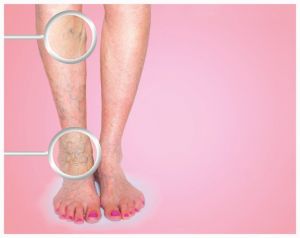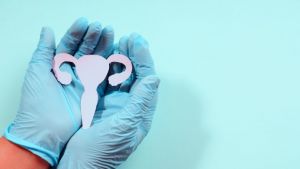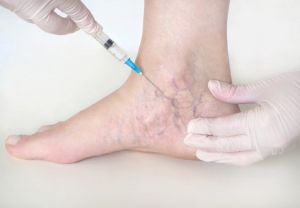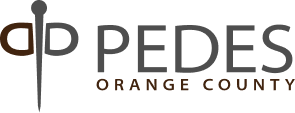Are Women at Higher Risk for Varicose Veins?

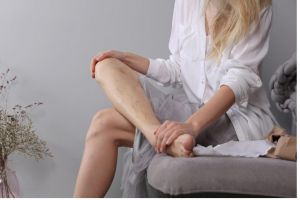
What are varicose veins?
Varicose veins are bulging veins that run just beneath the surface of the skin. These veins will commonly appear on the legs and feet. They are a result of malfunctioning valves in inside the unhealthy vein. When these valves malfunction, blood is not pushed upwards back towards the heart. Instead, unhealthy valves cause blood to flow backward. The blood then pools and causes the vein to deform and bulge. Varicose veins usually do not warrant a serious cause for concern. However, they can be painful and create discomfort around your legs and feet.
When inflamed, varicose veins become tender and sore. This can cause itchy skin, swelling, and aching in the legs. In severe cases, the varicose vein may rupture, leading to non-healing wounds on the legs and ankles.
Varicose veins are extremely common, currently affecting over 40 million Americans. There are even certain factors that can increase an individual’s risk of developing varicose veins.
Varicose Veins Risk Factors:
- Aging
- Gender (women are at higher risk)
- Pregnancy
- Family history
- Obesity
- Inactive lifestyle
Lifestyle changes can help to combat the uncomfortable symptoms associated with varicose veins. For example, getting daily exercise and eating a balanced diet can combat obesity and inactivity, thus combating the development of varicose veins. However, some of these risk factors are out of the individual’s control, such as age and gender. Women are four times more likely to develop varicose veins than men, but why?
Varicose Veins in Women
Why are women at higher risk?
Hormones play a large role in the link between varicose veins and women. Female hormones, such as estrogen and progesterone, can impact the menstrual cycle, pregnancy, and physical development. As women age, their hormone levels can fluctuate. Around age 50, the ovaries begin to produce decreased amounts of estrogen and progesterone. This can lead to mood swings, hot flashes, insomnia, weakened bones, and more.
Studies have found that over 40% of American women may develop varicose veins at some point in their lives. Research also shows that 22 million women between the ages of 40 and 80 are affected by varicose veins.
Why are hormones a contributing factor in women?
Understanding the risk factors associated with varicose veins can help patients seek treatment early on. The circulatory system, comprised of both veins and arteries, is in charge of moving blood properly throughout our bodies. Arteries carry blood away from the heart, while veins carry blood to the heart. Unlike the arteries, veins do not have a strong muscular layer. Instead, they rely on one-way valves to prevent blood from flowing backward. Over time, changes in hormone levels can reduce these valve’s efficiency, thus weakening the vein walls. As a result, blood accumulates in the vein and stretches out the walls, producing the twisted, bulging veins you see on the surface of your skin.
Varicose vein treatment at Pedes Orange County
At Pedes Orange County we treat the entire venous system. Varicose veins are commonly an indication that there are diseased veins throughout the entire venous system. Our treatment offerings target unhealthy veins in the entire venous system.
Think of your veins like a tree, your deep veins are the tree trunk, and your superficial veins are the branches of the tree. If the trunk is sick, the branches are weak. It is common to encounter facilities that only treat your superficial veins and ignore treating the deep veins. At Pedes Orange County we provide the most comprehensive and durable treatment for veins. By targeting treatment to both the deep and superficial veins, your legs will feel just as good as they look!
Our minimally-invasive treatment options
Radiofrequency ablation (RFA) uses heat to cause the abnormal veins to scar and eventually be absorbed by the body. RFA utilizes high-frequency radio waves directed through a catheter to create intense heat within the varicose vein. The varicose vein will then close, scar, and eventually be dissolved by the body. This will eliminate the bulging of the varicose veins and the discomfort associated with those veins. Performance of this treatment is carried out in an outpatient clinic, with minimal recovery time, and with mild discomfort post-procedure.
Venaseal is a minimally invasive procedure that injects a small amount of a specially formulated medical adhesive to seal, or close, the diseased vein. The body then dissolves the vein.
A laser is a non-invasive treatment that delivers laser energy in short bursts. The blood vessels absorb the energy, which causes the vein to shrink to disappear. There is no downtime and minimal post-procedure pain.
Sclerotherapy is a minimally invasive procedure in which we inject solutions into the veins that causes the veins to close off, scar, and disappear. This generally involves multiple treatments over several months.
Regardless of risk factors or not, varicose veins could happen to anyone. With a condition as common as this one, it is comforting to know that minimally invasive treatment options are available to you. If you’d like to learn more about our treatment methods, schedule a consultation at Pedes Orange County today!




